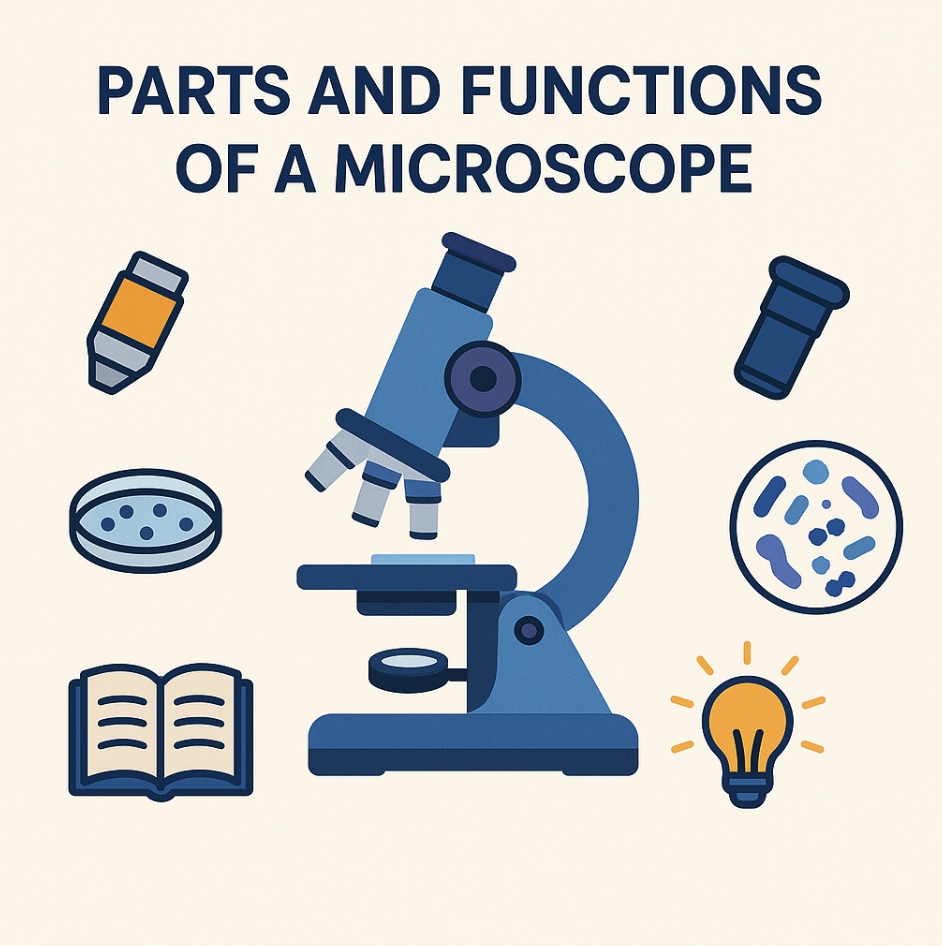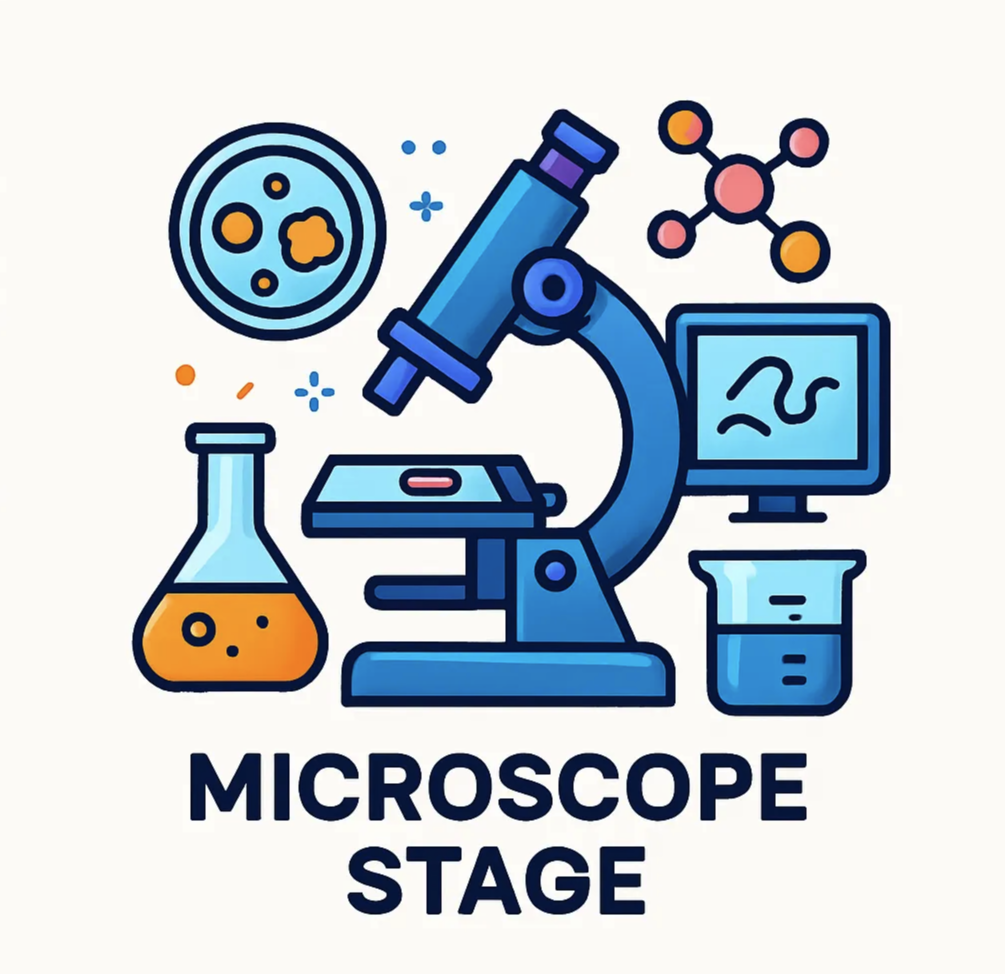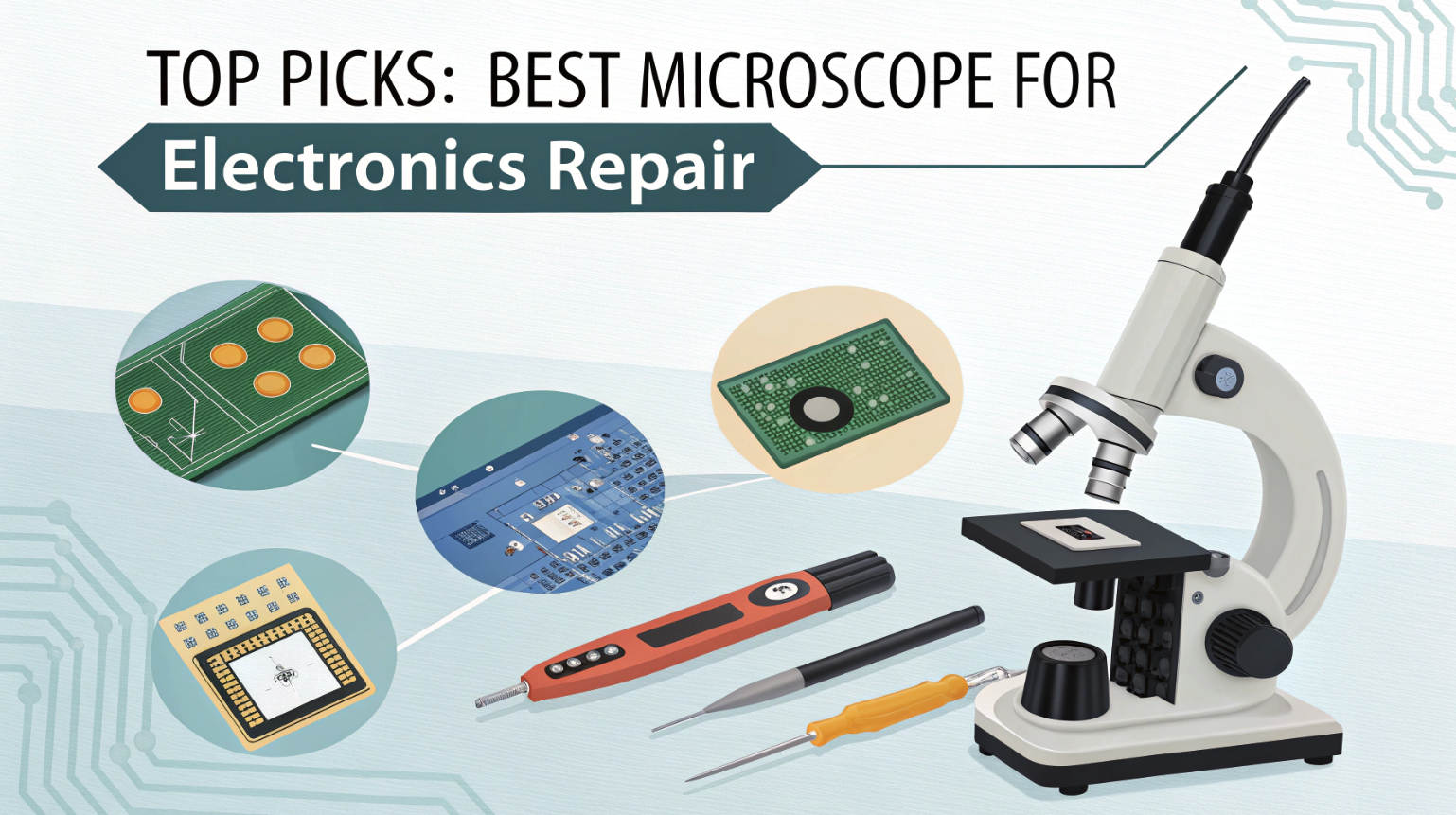
This guide provides comprehensive insights to help both beginners and professionals select the best microscope, enhancing their repair efficiency and effectiveness.
Are you struggling to see the finer details in your electronic repair projects? A good microscope is not just a tool—it’s your gateway to mastering the complex world of electronics repair. As devices get smaller and their components more intricate, having the right magnification tool at your workbench becomes indispensable. Whether you’re a seasoned technician or a hobbyist, understanding the nuances of microscopes tailored for electronic repairs is crucial.
This handbook helps you explore the spectrum of microscopes and pick the model that meets your requirements. From stereo and digital units to their USB counterparts, it details their properties, advantages and optimal applications. By the end of this post, you’ll not only know which microscope to choose but also why it’s a critical investment for accurate, efficient repair work.
Let’s zoom in and start deciphering the tiny complexities of electronic components together!
- 🔊 Play Audio Version
- Why Use a Microscope for Electronics Repair?
- Top Microscopes for Electronics Repair - Features and Reviews
- Key Features to Consider When Buying a Microscope for Electronics Repair
- How to Set Up Your Microscope for Electronics Repair
- Troubleshooting Common Issues with Electronics Repair Microscopes
- Additional Considerations
- Summing Up
- BONUS: Additional Microscope Models for Electronics Repair
- Useful Reads
🔊 Play Audio Version
Why Use a Microscope for Electronics Repair?
Microscopes provide the necessary magnification and clarity for identifying faults and executing delicate repairs that would otherwise be impossible with the naked eye. More importantly, they reduce the risk of causing further damage to the electronic components, which can be costly.
For anyone serious about electronics, a microscope is an invaluable investment that enhances the accuracy, efficiency, and quality of their work.
- Enhancing Precision: Allows detailed visibility to minute components, crucial for complex repairs.
- Improving Repair Quality: Precise repairs increase the longevity and functionality of electronic devices.
- Safety Considerations: Helps prevent eye strain and potential accidents associated with handling small parts.
| Benefit | Description | Importance in Electronics Repair |
|---|---|---|
| Enhanced Precision | High magnification reveals minute defects. | Essential for working with micro-components. |
| Improved Quality | Detailed view leads to better repair outcomes. | Increases device reliability and repair success. |
| Safety | Prevents direct eye strain with magnified views. | Essential for long-term health and accuracy. |
Whether you are just starting out or are an experienced technician, understanding how to use a microscope effectively can transform your approach to electronic repair. This guide will explore different types of microscopes, key features to consider, and how to choose the best microscope suited for your specific electronic repair needs.
Through this exploration, you will gain deeper insights and confidence in selecting and using the right tool, ensuring your efforts in electronics repair are both successful and enjoyable.
Types of Microscopes Used in Electronics Repair
Choosing the correct type of microscope is critical for efficient and accurate electronics repair work. Here, we explore the various types of microscopes specifically designed for this purpose, detailing their features and best uses.
Understanding these options will help you select the most suitable microscope for your repair tasks.
Stereo Microscopes
Stereo microscopes are ideal for electronics repair because they provide a three-dimensional view of the object, allowing for better depth perception which is vital when working with circuit boards and larger components.
- Magnification: Generally ranges between 10x to 40x.
- Field of View: Wider than in high-magnification microscopes.
- Work Distance: Typically provides more space between the microscope lens and the object, facilitating manual work on the item being examined.
Digital Microscopes
Digital microscopes offer higher magnification options and the ability to connect to a computer or display the image on a screen, which can be extremely helpful for detailed analysis, documentation, or sharing work with colleagues.
- Magnification: Can vary widely; some models offer up to 1000x magnification.
- Resolution and Image Quality: High-resolution images are a staple, making it easier to spot minute defects.
- Connectivity: Features such as USB or HDMI allow for easy data transfer and direct viewing.
USB Microscopes
USB microscopes are more portable and generally more affordable, making them a good entry point for hobbyists or for professionals who need a mobile solution.
- Magnification: Varies, with many models offering from 20x to 200x.
- Portability: Compactly designed for use on the go.
- Ease of Use: Direct plug-and-play connection with a computer via USB.
| Microscope Type | Magnification | Key Features | Ideal for |
|---|---|---|---|
| Stereo | 10x to 40x | Wide field of view, long working distance | Soldering, assembling, inspecting parts |
| Digital | Up to 1000x | High resolution, screen connectivity | Detailed work, diagnostics, documentation |
| USB | 20x to 200x | Compact and portable, easy setup | Quick checks, field work |
Even if you are a professional working in a lab or just a hobbyist setting up a home workshop, understanding the specific attributes and advantages of each type of microscope can significantly enhance your electronics repair capabilities. Consider the tasks you most frequently tackle, the level of detail required, and your working environment when choosing the right microscope.
This tailored approach ensures you can conduct thorough and effective repairs with the precision that modern electronics demand.

Top Microscopes for Electronics Repair – Features and Reviews
Selecting the best microscope for electronics repair can significantly impact the accuracy and efficiency of your work. Here, we review top microscope models categorized by type—stereoscopic, digital, and USB—highlighting their features, pros, and cons to help you make an informed decision.
Review of Top Stereoscopic Microscopes
Stereoscopic microscopes are favored for their ability to provide a three-dimensional view, which is imperative when performing tasks that require depth perception such as soldering or reworking circuit boards.
Model Examples:
- AmScope SE400-Z: This model offers a 10x to 20x magnification which is ideal for basic electronics work, with a long working distance that allows plenty of room for tools.
- Vision Engineering Mantis Elite: Known for superior optical performance and ergonomics, this is perfect for prolonged use without causing eye or neck strain.
Best Digital Microscopes on the Market
Digital microscopes offer high-resolution images and the convenience of connecting directly to a computer or display, making them perfect for detailed analysis and documentation.
Model Examples:
- Celestron Pentaview LCD Digital Microscope: Boasts a 4.3 inch LCD screen with up to 240x magnification, and includes capture and storage capabilities.
- Dino-Lite AM4113T: Offers up to 220x magnification and features built-in adjustable polarization to reduce glare on reflective components.
Budget-Friendly USB Microscopes for Beginners
USB microscopes are accessible and easy to use, making them an excellent choice for hobbyists or beginners seeking a practical and cost-effective solution.
Model Examples:
- Plugable USB 2.0 Digital Microscope: A great starter microscope with up to 250x magnification, direct plug-and-play compatibility with a PC, and affordable pricing.
- Jiusion Digital Microscope: Offers up to 1000x magnification and includes a foldable stand for stability, perfect for detailed exploration at a low cost.
| Microscope Type | Model | Magnification | Notable Feature |
|---|---|---|---|
| Stereoscopic | AmScope SE400-Z | 10x to 20x | Long working distance for tool use |
| Stereoscopic | Vision Engineering Mantis Elite | Variable | Ergonomic design for comfort |
| Digital | Celestron Pentaview LCD | Up to 240x | Large LCD for easy viewing |
| Digital | Dino-Lite AM4113T | Up to 220x | Adjustable polarization for clarity |
| USB | Plugable USB 2.0 Digital | Up to 250x | Plug-and-play with PC |
| USB | Jiusion Digital | Up to 1000x | Foldable stand and high magnification on a budget |
For enthusiasts passionate about electronics repair, these reviews highlight not only the specifications but also the practical applications of these microscopes in a repair setting.
When choosing a microscope, consider both your current needs and potential future projects to ensure it will serve you well in the long term.
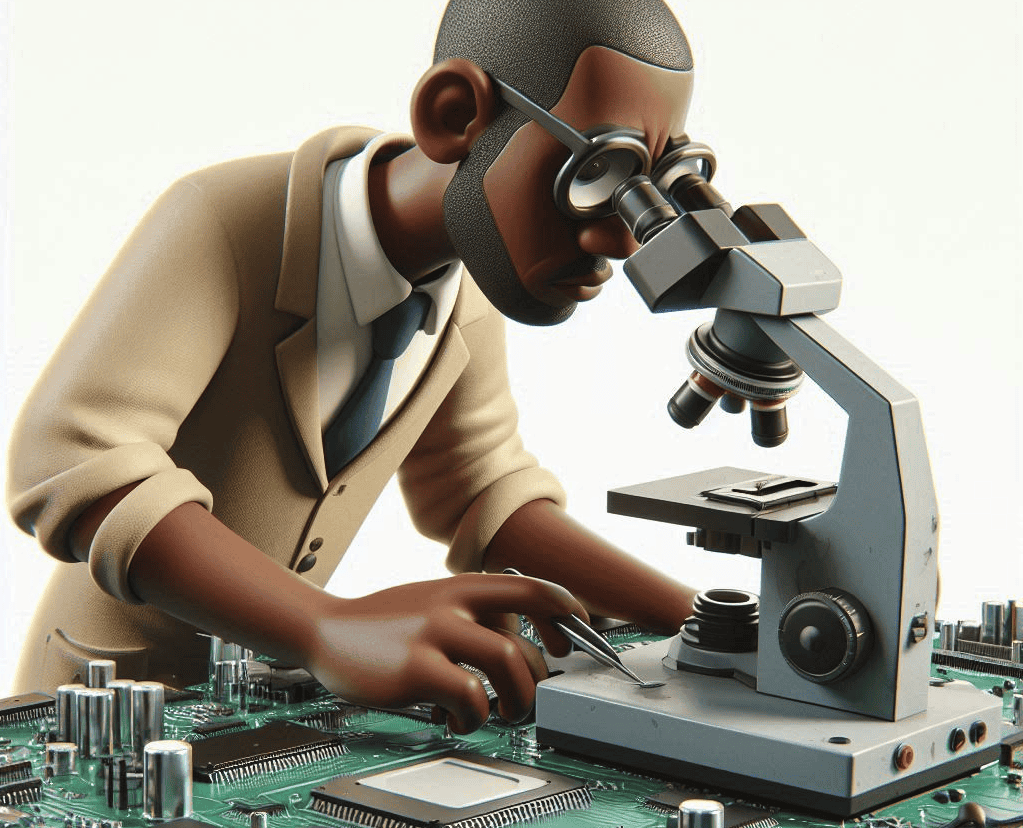
Key Features to Consider When Buying a Microscope for Electronics Repair
Selecting the right microscope is essential for effective electronics repair. Understanding key features such as magnification levels, resolution, working distance, and lighting will ensure the microscope you choose enhances your repair capabilities.
Each feature plays a significant role in how efficiently and accurately you can perform repairs.
Magnification Levels
Magnification is crucial for examining small components in electronic devices closely.
Microscopes with variable magnification settings allow you to adapt to different tasks, from viewing an entire circuit board at lower magnifications to zooming in on a tiny solder joint at higher magnifications.
Higher magnifications are particularly vital when conducting detailed work on micro-scale components common in modern gadgets.
Resolution and Image Quality
The resolution of a microscope affects the clarity and detail of the images it produces. High-resolution microscopes provide crisp, detailed views that are imperative for identifying faults and ensuring high-quality repairs, especially when working on complex electronic circuits.
A high-resolution microscope also aids in accurately documenting your repairs, which is beneficial for maintaining repair logs or sharing insights with other repair professionals.
Working Distance
Adequate working distance is important when using tools beneath the microscope lens. It facilitates easier manipulation of the device being repaired without the need to constantly re-adjust the microscope. This is particularly useful for tasks such as soldering or moving components, where space to maneuver tools is necessary.
A longer working distance also helps in preventing accidental damage to both the microscope and the electronic components.
Lighting and Brightness Controls
Effective lighting is essential for illuminating the intricate parts of electronic devices under examination. Microscopes with adjustable brightness and lighting options provide optimal visibility in various conditions, reducing eyestrain and enhancing the precision of your work.
LED lighting, known for its brightness and efficiency, is a popular choice as it evenly illuminates objects, enhancing both the usability and functionality of the microscope.
Here’s a table summarizing these features to help you in making a well-informed decision:
| Feature | Importance | Tips |
|---|---|---|
| Magnification | Essential for detailed views of small components. Choose a model that offers variable magnification. | Assess typical tasks to choose suitable ranges. |
| Resolution | High resolution provides clearer images for precise repairs. | High-definition or enhanced imaging is preferable. |
| Working Distance | Necessary for practical use of tools under the scope. | Ensure ample space for comfortable tool use. |
| Lighting and Brightness | Critical for visibility in detailed work. | Opt for adjustable and high-quality LED lighting. |
Understanding and evaluating these features will enable you to select the best microscope for your electronics repair needs, enhancing both your capability and efficiency in handling delicate repair tasks effectively.
How to Set Up Your Microscope for Electronics Repair
Setting up your microscope correctly is crucial for maximizing its effectiveness in the electronics repair process. Proper setup ensures that you get the best image quality and makes the repair process more comfortable and efficient.
This section guides you through the basic setup steps and provides tips for optimal usage.
Step-by-Step Setup Guide
Start by choosing a stable, vibration-free surface to place your microscope. Ensure the area is well-lit and free from dust. Attach the microscope to the stand, if it’s not already integrated, and connect any necessary power sources or cables.
Align the light source properly—most modern microscopes come with LED lights that provide clear, bright illumination. Adjust the focus and zoom according to the component you will be working on.
Tips for Optimal Usage
To get the most out of your microscope during electronic repairs, maintain a regular cleaning regimen for the lens and body to ensure clear visibility. Adjust the eyepiece to align your sight line comfortably, preventing eye strain during prolonged use.
Utilize additional accessories like Barlow lenses for increased magnification or a camera adapter to document your work process.
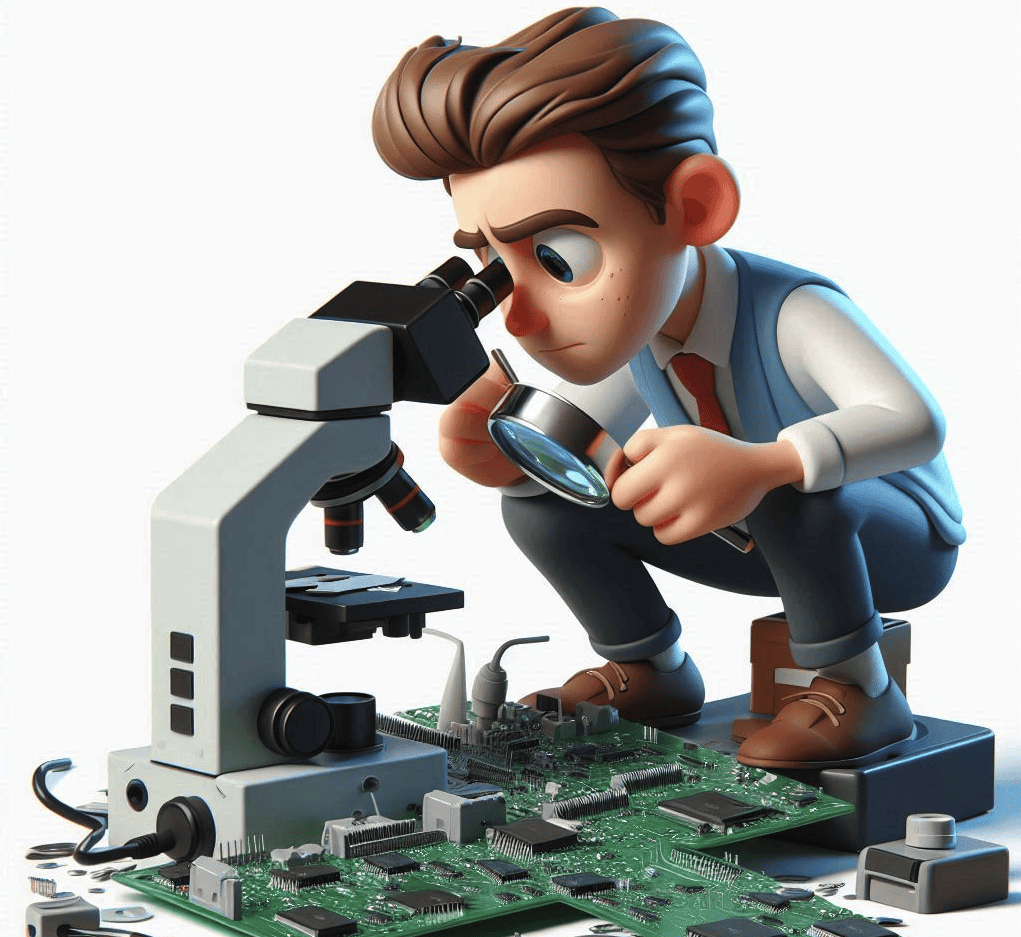
Here’s a table summarizing the key setup steps and usage tips:
| Setup or Usage Tip | Description | Benefits |
|---|---|---|
| Choose a Stable Surface | Ensure the microscope is placed on a stable, level surface. | Reduces vibration, enhancing image stability. |
| Proper Light Alignment NY State | Align the microscope’s light for optimal illumination. | Improves visibility and accuracy of repairs. |
| Regular Cleaning | Clean the lens and microscope body regularly. | Maintains clarity and performance. |
| Suitable Eyepiece Adjustment | Adjust the eyepiece to a comfortable setting. | Prevents eye strain and enhances focus accuracy. |
| Use Relevant Accessories at – | Utilize accessories like additional lenses and cameras. | Extends the microscope’s versatility and utility. |
Setting up your microscope properly is the first step to successful electronic repairs. By following these guidelines and making adjustments that suit your specific needs, you can create an efficient, ergonomic workstation that facilitates precision in every task.
Whether you’re a hobbyist or a professional, these tips will help you harness the full potential of your microscopy equipment in electronics repair.
Troubleshooting Common Issues with Electronics Repair Microscopes
Even with the best equipment, encountering problems with your microscope during electronics repairs is not uncommon. Understanding how to quickly identify and resolve these issues can save time and prevent frustration.
This section addresses some common challenges you may encounter and provides practical solutions to ensure your microscope continues to function optimally.
Common Operational Challenges
One frequent issue with microscopes in electronics repair is blurry images. This can often be attributed to dirty lenses or improper adjustments of focus.
Another common challenge is insufficient lighting, which makes it difficult to see detailed components clearly. Ensure that your microscope’s lighting settings are correctly adjusted and that the light source is functioning properly.
Maintenance Tips
Regular maintenance is crucial to keep your microscope in prime condition. Always handle the lenses with care, using lens paper for cleaning to avoid scratches.
Check and replace any old or malfunctioning light bulbs, and ensure all moving parts are properly lubricated to prevent stiffness or wear over time.
Here’s a table summarizing common issues and their solutions:
| Issue | Common Causes | Suggested Solutions |
|---|---|---|
| Blurry Images | Dirty lenses, improper focus | Clean lenses regularly, adjust focus correctly |
| Insufficient Light | Dim bulbs, incorrect light placement | Replace bulbs, adjust light alignment |
| Stiff Adjustments | Lack of lubrication, dust accumulation | Lubricate moving parts, clean regularly |
Understanding these common issues and how to address them can significantly enhance your experience and productivity when using a microscope for electronics repair. Regular maintenance not only prolongs the life of your microscope but also ensures it provides accurate and reliable support for your repair tasks. Whether you’re dealing with complex circuit boards or simple component replacements, knowing how to troubleshoot your equipment effectively is an invaluable skill for any electronic repair enthusiast.
Additional Considerations
When using a microscope for electronics repair, it’s essential to consider ergonomics and workstation setup. Proper ergonomics can prevent strain or discomfort during prolonged repair sessions.
Ensure that your microscope setup allows for comfortable posture and that the working area is at a suitable height and distance from your body. Consider using ergonomic accessories such as adjustable stands, armrests, and ergonomic chairs to support your body and prevent fatigue.
A well-designed and ergonomic workstation setup contributes to a more productive and comfortable electronics repair experience.
Summing Up
Choosing the right microscope for electronics repair is a crucial step that can significantly enhance the precision and effectiveness of your work. Throughout this guide, we’ve explored various types of microscopes, discussed key features to consider, and provided tips for setting up and maintaining your device.
Remember, the best microscope for you depends on your specific needs and the complexity of the tasks you handle.
BONUS: Additional Microscope Models for Electronics Repair
When it comes to electronics repair, having the right microscope can make all the difference. There are several popular microscope models that are widely used by professionals in the field. These microscopes offer advanced features and reliable performance to ensure accurate and precise electronic repairs.
Let’s take a closer look at some of the most popular microscope models for electronics repair:
Jiusion 40 to 1000x
The Jiusion 40 to 1000x microscope is a versatile option that offers a wide range of magnification options. With its compact design, it is highly portable and suitable for use in various locations. Whether you’re working on small electronic components or circuit boards, this microscope provides the magnification you need for detailed inspections and repairs.
Andonstar AD207
The Andonstar AD207 microscope features a large LCD screen and HDMI output, providing a clear and detailed view of the electronics being repaired. This microscope is equipped with high-quality optics that ensure excellent image quality, making it easier to identify and troubleshoot issues. The Andonstar AD207 is a reliable choice for professionals who require precise and accurate electronic repairs.
AmScope SE400-Z
The AmScope SE400-Z is a budget-friendly stereo microscope that offers a wide working area and adjustable lighting. Its ergonomic design ensures comfortable use during prolonged repair sessions. This microscope is suitable for a wide range of electronic repair tasks and provides reliable performance without breaking the bank.
TAGARNO ZIP
The TAGARNO ZIP microscope is known for its high-quality optics and ergonomic design. It offers excellent image clarity and resolution, allowing for precise inspections and repairs. The ergonomic design of the TAGARNO ZIP ensures comfortable use, making it ideal for prolonged repair sessions. If you’re looking for a microscope that combines performance and comfort, the TAGARNO ZIP is a great choice.
Consider these popular microscope models when searching for the best microscope for your electronics repair needs. Whether you’re a professional technician or a hobbyist, having a reliable and effective microscope is essential for accurate and efficient electronic repairs.

